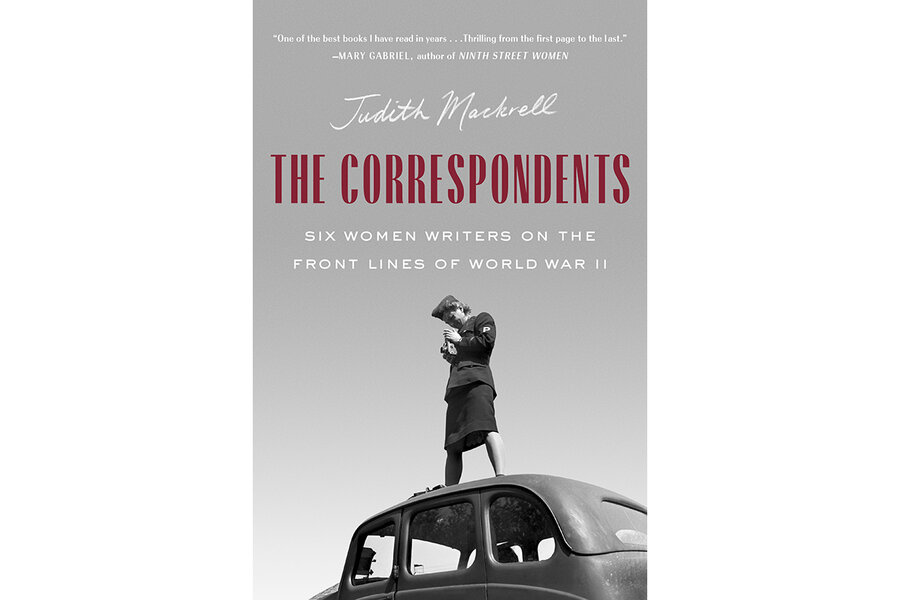‘The Correspondents’ portrays bold female reporters in World War II
Loading...
Clare Hollingworth, the British reporter who broke the news of the start of World War II, was always ready to travel to a combat zone as long as she had her “T and T” (toothbrush and typewriter). But as Judith Mackrell recounts in her thrilling new book, “The Correspondents: Six Women Writers on the Front Lines of World War II,” sometimes she needed more than that. When the Nazis invaded Warsaw in 1939 and journalists were evacuating Poland, Hollingworth, then in the Polish city of Krzemieniec, was riveted by the prospect of having exclusive access to the action. She commandeered a car, “tucked a revolver in the glove compartment,” and tried, unsuccessfully, to enter the Polish capital.
“The Correspondents'' is packed with such details. But it is above all the courage and tenacity of Mackrell’s subjects that impresses. They risked their lives just as their male counterparts did, but unlike the men, they also had to do their work in the face of stubborn discrimination. Reporting on the D-Day invasion from France, for instance, the men in the press corps were provided typists and radio transmitters with which to file their dispatches while the women had to fend for themselves. Regularly barred from combat zones or told to focus on “the women’s angle,” they frequently broke the rules in order to cover the war in the way they wanted.
Mackrell believes that the obstacles the women endured ended up enriching their writing. “It was the restrictions imposed on women which, ironically, led to their finding more interestingly alternative views of the war,” she argues. “Their reporting often had a different colour and a different heartbeat from that of their male colleagues.”
In addition to Hollingworth, who wrote for the British paper The Daily Telegraph during the war, Mackrell profiles five American women: Martha Gellhorn, who reported on D-Day for Collier’s after stowing away on a Red Cross ship to Normandy; Lee Miller, a fashion model turned fashion photographer turned war correspondent who documented the action for Vogue; Virginia Cowles, a former fashion and society columnist who zigzagged across Europe and North Africa reporting for the Hearst papers and Britain’s Sunday Times; Helen Kirkpatrick, a Chicago Daily News reporter who, on the order of Gen. Dwight Eisenhower, became the first woman correspondent in an Allied war zone granted equal privileges with men; and Sigrid Schultz, the Berlin bureau chief for the Chicago Tribune (she was the first woman to head an American foreign bureau) who covered the early rise of Nazism and was among the first journalists to see the Buchenwald concentration camp.
Of the five, Gellhorn and Miller are the best known. Gellhorn was married to Ernest Hemingway. They had covered the Spanish Civil War together, but by the time World War II broke out, they had retreated to an estate in Cuba to write fiction. Later, Mackrell writes, Gellhorn would “reflect on her Cuban idyll with some shame.” Yearning to be at the center of the action again, she returned to Europe to cover the war. She kept extending her stay until a furious Hemingway demanded, “Are you a war correspondent or wife?” Gellhorn chose the former, and they were divorced by 1945.
Miller was a model before becoming the muse and protégé of surrealist photographer Man Ray. She then embarked on a successful career in fashion photography, but her photographs of life in London under the Blitz led her to transition to photojournalism. British Vogue welcomed war coverage, dispatching Miller to document battles across Europe. When Paris was liberated, however, her editor sent her there for a story on what women were wearing. Back on the fashion beat, Miller grumbled, “It is very bitter to me to go to Paris now that I have a taste for gunpowder.” She later was one of the first journalists to see the Dachau concentration camp, and she was determined to photograph every horror she encountered. After the war, she battled severe depression and alcoholism. “I could never get the stench of Dachau out of my nostrils,” she said.
In recent decades, the landscape has greatly evolved. The assumptions that held female war correspondents back – that they couldn’t tolerate witnessing violence and death, and, on a more mundane level, that they couldn’t handle a lack of bathroom facilities (what the American military called “the latrine business”) – are largely moot now that women serve in combat positions in armed forces worldwide. The six journalists profiled in “The Correspondents” deserve credit for their pioneering work. Fortunately for us, their life stories make for vivid and fascinating reading, too.






